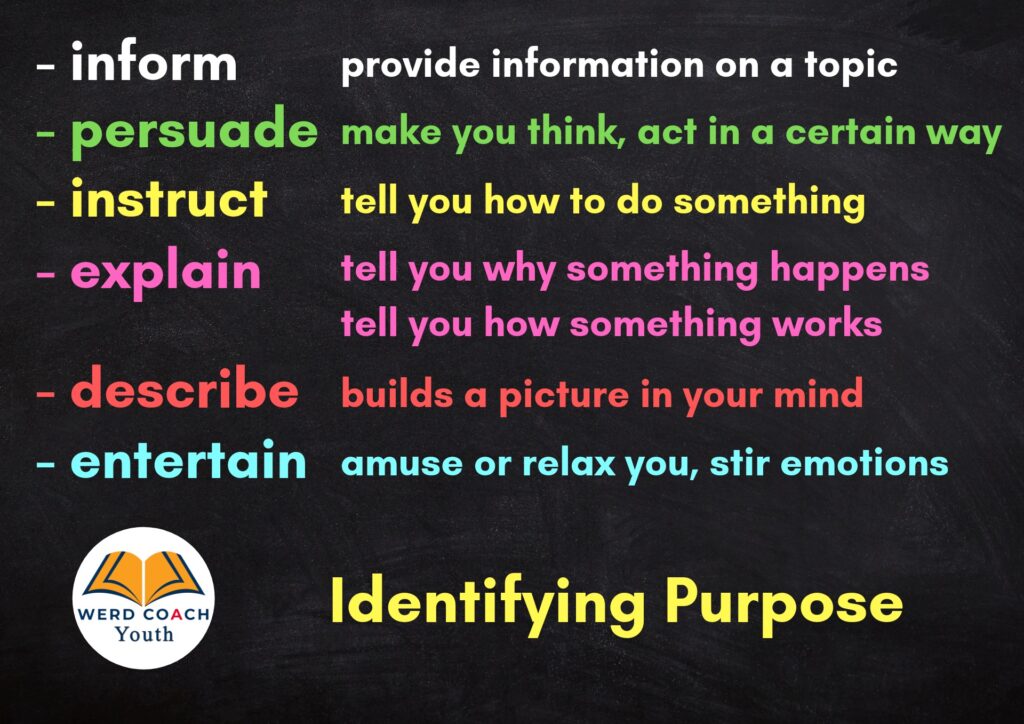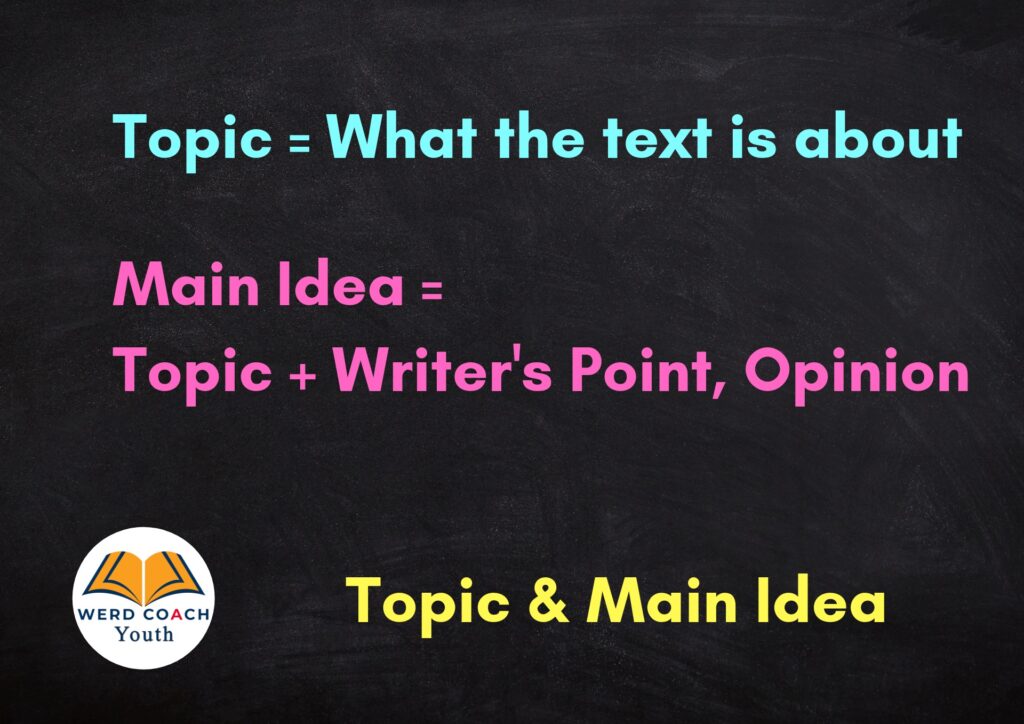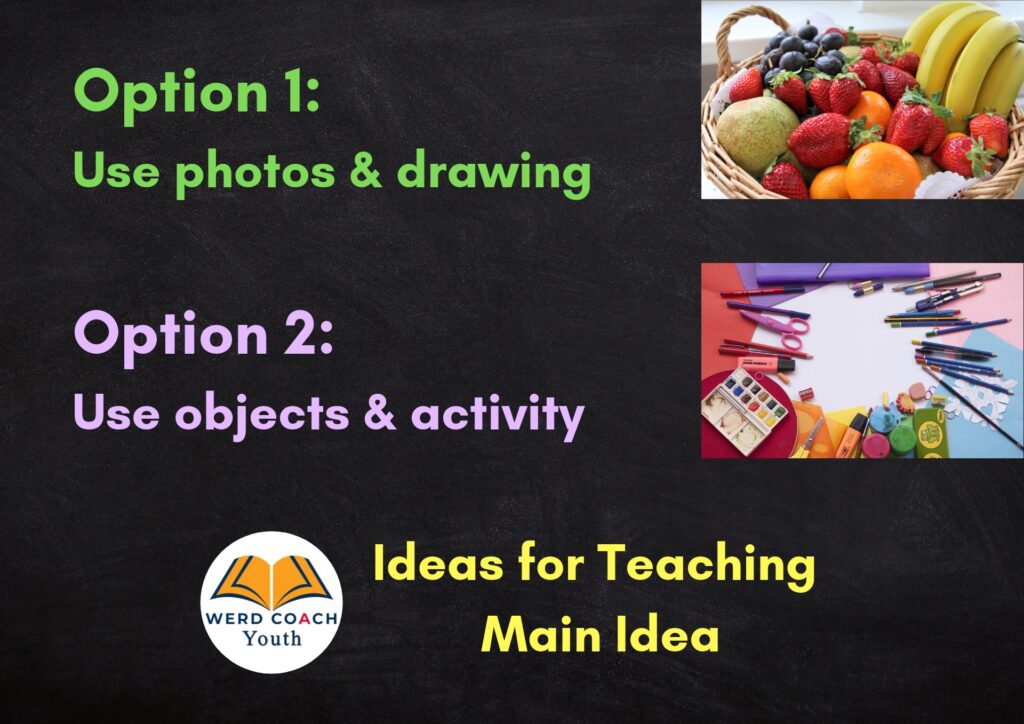Today we continue with our discussion on how to improve reading comprehension. This post is about main ideas and purpose. I’ve also added in the concept of ‘topic’ because all three are connected when it comes to understanding what we read.
- The first step toward figuring out main ideas and purpose, is to understand that writing is communication. There is a writer, the person composing the message. There is the text, which contains the message. And, there is a reader, the person deciphering the message. Readers should remember that there is another person at the other end of the experience who created the text for a reason.
- Once readers recognize the role of the writer in creating the text, then we can ask ourselves a few questions regarding the writer’s intentions. Even before we think about main idea, we should ask ourselves why the writer created the text. Answering ‘why’ leads to identifying purpose. Why did the writer create this text? What were his or her intentions? What was he or she hoping to do? Remember, writing is communication, so think of what impact the writer hoped the text would have on the reader.
- After identifying purpose, consider what the text is about. What is the topic? What is the text about? The topic of a text is what the writer is talking about. To find the topic, check each sentence to see what details are provided. Repeated words give an idea of the topic, although sometimes synonyms are used, so keep an eye out for those.
- The main idea is what the writer is saying about the topic. It’s the writer’s opinion, main concern, or belief about the topic. Sometimes the main idea is stated in a sentence, and sometimes information is given that guides readers to an implied main idea. The main idea is often influenced by the purpose, so knowing purpose first helps in understanding and identifying the main idea, especially when the main idea is implied.
- In short, the purpose is the reason the writer created the text. The topic is what the text is written about, and is often a single word or phrase. The main idea is what the writer wants us to know about the topic, and is usually expressed in one or two sentences.
Main idea, topic, and purpose are connected.
Teaching them together within an overall view of writing and reading as communication between a writer and a reader, allows students to place the concepts within a real-world context.

Two practical ways to decipher purpose:
1. Knowing the source of a text and its intended audience can assist in determining its purpose. This means thinking about who wrote the pamphlet, and who they wrote it for.
Government and academic sources are more likely to be informative than business or magazine sources.
2. Observe the language and the way content is delivered. Short and direct sentences usually mean some type of instruction. Longer sentences using adjectives and descriptive language, point toward description. Formal, impersonal language usually means an intent to explain or inform, and opinions supported by evidence, or an appeal to emotions is used to persuade.
NOTE: The three main purposes are Persuade, Inform, and Entertain. Instruct and Explain are often positioned under Inform. Describe can be placed under entertain.

Knowing the purpose of a text helps in figuring out the main idea. Here are a few variations to questions you can ask about purpose to help determine the main idea.
Inform – What is the main thing writer telling me about this topic?
Persuade – What does the writer want me to do or think? What’s the opinion the writer is trying to get me to agree with (or disagree with)?
Describe – What picture is the writer trying to get me to imagine? What is the writer saying about that picture?
Instruct – What is the writer trying to get me to accomplish?
Explain – What is the writer saying (opinion) about what happened, or how something works?
Entertain – What emotion is the writer trying to get me to feel?
NOTE: If the text is a poem, play, or story, chances are the purpose is to entertain. The main idea of these types of texts are often connected to themes, which go a bit beyond the obvious ideas to a message the writer is trying to convey. Theme will be discussed in another post, as it does not particularly apply to the SEA context.

Some children have difficulty understanding the abstract thinking required to determine main idea because they think quite literally. If the main idea isn’t stated explicitly, it’s often challenging to decipher it. To assist such children in grasping the concept, visual, tactile, and kinesthetic activities can be incorporated into the instruction.
Identifying the main idea is like putting a label on a group of similar ideas. So, getting children to work on grouping items, finding similarities between a group of objects they can see and manipulate, can assist them in moving toward the more abstract concept of main ideas in texts.
Option 1: asks the teacher to present photos of related objects.
For example, choose a game like cricket or football and present 5 to 7 photos of objects related to the game. The children have to guess what is the common idea/theme. Other possibilities include any sport, parts of a house, fruits, vegetables, and any group that can be represented with photos. Students may also be presented with several mixed photos and asked to group them, and label the group. Additionally, they may be asked to draw items to create their own groups.
Option 2 is an alternative to the photo activity which involves physical objects and a container, a bag, or box, to house the objects.
A class may be divided into teams, and each team has to go around the classroom and create a main idea concept using objects they find. The activity helps children group ideas into topics, and the concept of opinion can be introduced using emojis or other symbols. Students may even create their own emojis or symbols to express opinions on the topics represented by the objects in the box or bag.
In addition to creating and explaining their main idea box/bag contents, other teams may be asked to guess rather than being told. Students can then verbally express main ideas, recognize the difference between main ideas and topics, and understand that supporting details are important in establishing main ideas. This applies to both comprehension and writing.

